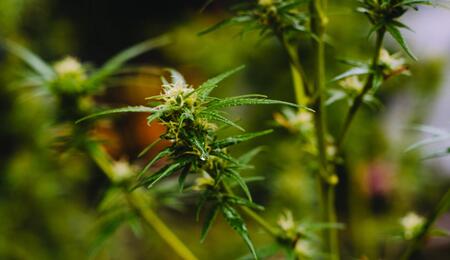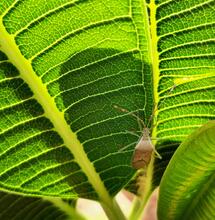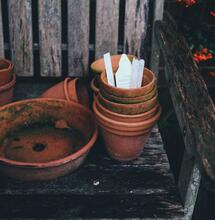Start Your Organic Cultivation of Marijuana in Live Soil

Tip No. 1: For greater successes with your organic cultivation of marijuana work in team rather than alone. So why not add new members to your team? Tip No.2: If you use "live" or "no-till" soil as a growing medium and add beneficial organisms to it, you can improve the state of your organic marijuana crop and ultimately your entire harvest.
Using living soils has advantages, especially since plant roots absorb nutrients more easily. In addition, you reduce the frequency of irrigation, plants do not erode as much, improve ventilation and our precious crops are more protected from the most dangerous harmful organisms.
Organic cultivation of marijuana
Growing marijuana plants in pots/containers using organic soil requires a radical change of mind, compared to more conventional techniques, which use liquid fertilizers to feed plants directly with ionic nutrients. At the end of the day, we are talking about a living ecosystem.
For example, you never have to do root washing because you are not applying salts to the soil during the irrigation/watering process at any point in the cycle. Also, if you grow marijuana in live, well-maintained soil, you don't need to check the water's pH or EC levels.
The pH will achieve a balance thanks to the interactions of the plant and the microbes that support its growth in the soil. Do not panic! Ecological growth in living soil requires sufficient volume to maintain a healthy and active microbiological community that constantly dissolves organic nutrients so that marijuana can absorb them.
This is throughout the growth cycle. The microscopic life on Earth is one of nature's best-kept secrets. Living soil is the community of organisms that work together to break down the organic matter in the soil, which, in turn, provides valuable nutrition to plants and other organisms around them. The living soil without tillage works with its own ecosystem, it feeds itself and it nourishes the plants that compose it by means of a "food web of the soil", made up of bacteria, fungi, protozoa, nematodes, earthworms, anthropoids and a large number of organisms alive.
The decomposition process follows the same steps: Organic matter accumulates in the soil, where decomposers such as bacteria, fungi and nematodes rapidly transform it on a microscopic scale. Then organisms like nematodes and protozoa arrive on their own and feed on bacteria and fungi, later anthropoids (small insects) come to feast on until small animals eat them. Thus, the food chain follows its process from the smallest to us. The process converts nutrients in different ways, makes them more accessible to plants through its root system (exudates).
A soil that does not have beneficial organisms is not alive and needs a nutritional supplement, through botanical preparations and compost teas. Although many of the organic fertilizers sold in the market provide a large part of the nutrients that plants need to develop, the natural process of the mother earth is more lively (without problems of the plants burning with overexposure to the fertilizers, for example).
At the same time it is more effective, plant feeding is a natural by-product of the most complete process. Nature is very well made, and everything is perfectly situated. And not only that, but the worms and insects that live in the soil help to keep it ventilated, allowing the roots to stretch and helping plants to grow more voluminous and in very good health. Soil organisms also help regulate harmful organisms and improve water retention, thus reducing the attention required for the growth of large marijuana crops, compared to conventional crops.
Why agriculture without tillage?
Tillage speeds up the decomposition process, but also considerably reduces the life expectancy of organisms that live in the soil. Excessive tillage basically kills the organisms that live in the soil instead of feeding them. Instead of working the soil, it is important to let the process flow, which allows other organic matter to accumulate on the surface.
This is important to know for your efforts in the organic cultivation of marijuana. Mother Nature will take the reins on its own, attracting solid matter in the soil to increase the amount of active organic matter in the soil, thus improving the cation exchange capacity (CEC) of cultivated soils. Since organic matter is the only source of energy and nutrition, improving this parameter in your crops is beneficial.
Creating a living soil for your organic cultivation of marijuana
While adding live organisms, bacteria, and fungi to your marijuana grow may seem counterproductive and dangerous, in practice it is not at all. In fact, some of the best marijuana in the world is grown using live, nutrient-rich soil that allows the plant to fully exploit its genetic potential.
Growing your plants in living soil can greatly increase the quality of the buds. When the soil works to feed and protect the plant at the same time, it does not need to supplement with potent pesticides, fungicides or fertilizers at all, as in conventional agriculture.
Work out the details
The optimal size of the container of your crop is totally related to the size and age of the plant. A clone in the vegetative phase for four weeks, which can then flower for an additional eight weeks, will achieve its full potential in a pot filled with a fantastic 50L mix of living soil minimum.
This size will allow the plant to come out with a balanced diet of vitamins, minerals and other trace elements and nutrients. However, if you put an outdoor plant for a full cycle in the same container, the growth process will take twice as long. In this case, it may be that the microbiology does not respond to the demands of the plant, then you will have to plan it accordingly.
Make sure to give enough soil volume in relation to its size and the length of the season. Although the specific soil recipe changes depending on the grower, and is often the best-kept secret, all living soils have the following elements:
Minerals
The parts that usually compose the soil can be divided into three categories: clay, sand and organic matter. The different relationships between minerals can affect soil density and other characteristics, making it more or less attractive for the production of marijuana.
Water
Like all living things, the soil needs water to live. Soil uses water in three different ways: it sinks to the bottom quickly and easily to bring water and nutrients to plant roots, it is stored in porous minerals for later use (such as water bubbles caught in the stones of the soil), and contributes water to the microbes, to allow them to develop and contribute effectively to the health of the soil. Quality water is essential, we could write an entire article on this important subject, there are many things to know. The chlorine and chloramine in the tap water kill the life of the soil, you always have to filter the water first.
Air
The life in the ground, called aerobic, needs oxygen to survive. As a result of the complex cycle that makes living soil work without tillage, air and moisture are constantly recycled into the soil to keep the roots oxygenated, allowing them to breathe and better photosynthesis for plants.
Organic material
Organic matter forms the basis of all nutrition that your plants will need. So you cannot underestimate its importance. It is made up of decomposing plant or animal materials, the organic additives in the soil have to be broken down by microorganisms if we want plants to use them. Common organic additives in soil include compost, residues from cutting plants and their trunks/branches, manure, worm droppings, and a host of other natural products.
Microorganisms
Microorganisms are the key to turning organic matter into useful nutrition for your plants, but not all organisms are created equal (and neither are all pests made equal). The only microorganisms that should get into your soil are aerobic microbes (the ones that breathe oxygen).
Anaerobic microorganisms such as Clostridium, for example, destroy useful bacteria by promoting the growth of pathogenic bacteria in crops. As for aerobic bacteria, they completely digest organic compounds through their respiration process, thus improving the metabolic efficiency of the culture system.
Common aerobic bacteria used in marijuana cultivation can include bacteria that secrete selenium, boron, and nitrogen, and can be added to the soil in high concentrations with the help of compost tea. Marijuana cultivation has come a long way since the 1960s and '70s, producing larger, more resinous buds than many of the buds of before.
There is one thing we have learned, searching for the best marijuana, and that is that our Mother Nature has always been right, from the beginning. Whether outdoors or in a well-guarded indoor grow room, feeding marijuana with live soil can be the best way to achieve impressive results with minimal effort.



.png)